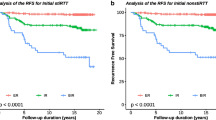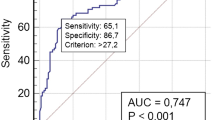Abstract
Purpose
To investigate the factors influencing the outcome of radioactive iodine (RAI) treatment in intermediate- to high-risk patients with differentiated thyroid carcinoma (DTC).
Methods
We enrolled 553 DTC patients who underwent total thyroidectomy and categorized them into two groups according to their response to RAI therapy: excellent response (ER) and non-ER groups. Clinical and pathological characteristics of the patients were collected and retrospectively analyzed using univariate and multivariate binary logistic regression. Receiver operating characteristic (ROC) curves and diagnostic cutoff values were analyzed to assess the predictive value of important quantitative influences on 131I treatment outcomes. A new nomogram model was developed based on the above independent risk factors. R software was used to develop nomograms with all the independent prognostic factors included.
Results
The multivariate analysis showed that lymph node metastasis (LNM), stimulated thyroglobulin (sTg), thyroglobulin antibodies (TgAb), and sTg/thyroid-stimulating hormone (TSH) were significantly associated with non-ER of DTC patients. In the training set, the consistency index (C-index) of the new column line graph was 0.868 (95% CI 0.865-0.871).
Conclusion
We proposed a new nomogram to predict non-ER for DTC with excellent discrimination and calibration.




Similar content being viewed by others
Data availability
The data used to support the findings of this study are available from the corresponding author upon request.
References
D.W. Chen, B.H.H. Lang, D.S.A. Mcleod et al. Thyroid cancer. Lancet 401(10387), 1531–1544 (2023). https://doi.org/10.1016/s0140-6736(23)00020-x
J.D. Lin, C. Hsueh, T.C. Chao, Long-term follow-up of the therapeutic outcomes for papillary thyroid carcinoma with distant metastasis. Medicine 94(26), e1063 (2015). https://doi.org/10.1097/md.0000000000001063
M. Schlumberger, S. Leboulleux, Current practice in patients with differentiated thyroid cancer. Nat. Rev. Endocrinol. 17(3), 176–188 (2021). https://doi.org/10.1038/s41574-020-00448-z
B.R. Haugen, E.K. Alexander, K.C. Bible et al. 2015 American Thyroid Association Management Guidelines for Adult Patients with Thyroid Nodules and Differentiated Thyroid Cancer: The American Thyroid Association Guidelines Task Force on Thyroid Nodules and Differentiated Thyroid Cancer. Thyroid 26(1), 1–133 (2016). https://doi.org/10.1089/thy.2015.0020
C. Sparano, S. Moog, J. Hadoux et al. Strategies for radioiodine treatment: what’s new. Cancers 14(15), (2022). https://doi.org/10.3390/cancers14153800
Y. Lin, T. Li, J. Liang et al. Predictive value of preablation stimulated thyroglobulin and thyroglobulin/thyroid-stimulating hormone ratio in differentiated thyroid cancer. Clin. Nucl. Med. 36(12), 1102–1105 (2011). https://doi.org/10.1097/RLU.0b013e3182291c65
Y.W. Chang, H.S. Kim, S.P. Jung et al. Pre-ablation stimulated thyroglobulin is a better predictor of recurrence in pathological N1a papillary thyroid carcinoma than the lymph node ratio. Int J. Clin. Oncol. 21(5), 862–868 (2016). https://doi.org/10.1007/s10147-016-0956-2
I.O. Amui, J.V. Tagliarini, E.C. Castilho et al. The first postoperative-stimulated serum thyroglobulin is a prognostic factor for thyroid microcarcinomas. Braz. J. Otorhinolaryngol. 85(1), 37–42 (2019). https://doi.org/10.1016/j.bjorl.2017.10.005
E. Karvounis, I. Kappas, A. Angelousi et al. The diagnostic and predictive accuracy of thyroglobulin to TSH ratio and TSH to thyroglobulin ratio in detecting differentiated thyroid carcinoma in normothyroid patients with thyroid nodules: a retrospective cohort study and systematic review of the literature. Oncol. Rev. 14(2), 439 (2020). https://doi.org/10.4081/oncol.2020.439
Y. Ju, L. Wang, F. Cheng et al. Comparing the efficacy of thyroglobulin and thyroglobulin/ thyroid-stimulating hormone ratio models in predicting a successful response to radioactive iodine therapy. BMC Endocr. Disord. 23(1), 19 (2023). https://doi.org/10.1186/s12902-022-01261-7
C. Lu, C. Wang, F. Li et al. The influence of stimulated thyroglobulin and lymphocyte subsets before radioiodine therapy on the therapeutic response in patients with intermediate- and high-risk papillary thyroid carcinoma. Clin. Exp. Med. (2022). https://doi.org/10.1007/s10238-022-00932-y
N. Dessoki, I. Nasr, A. Badawy et al. Value of the postablative thyroglobulin measurements for assessment of disease-free status in patients with differentiated thyroid cancer. Indian J. Nucl. Med. 34(2), 118–124 (2019). https://doi.org/10.4103/ijnm.IJNM_142_18
R.M. Tuttle, H. Tala, J. Shah et al. Estimating risk of recurrence in differentiated thyroid cancer after total thyroidectomy and radioactive iodine remnant ablation: using response to therapy variables to modify the initial risk estimates predicted by the new American Thyroid Association staging system. Thyroid 20(12), 1341–1349 (2010). https://doi.org/10.1089/thy.2010.0178
A.E. Llamas-Olier, D.I. Cuéllar, G. Buitrago, Intermediate-risk papillary thyroid cancer: risk factors for early recurrence in patients with excellent response to initial therapy. Thyroid® 28(10), 1311–1317 (2018). https://doi.org/10.1089/thy.2017.0578
Y. Zhang, C. Zhang, Y. Ma et al. Prediction to the prognosis of children with neuroblastoma by nomogram based on the first-diagnosed inflammatory markers. Pediatr. Surg. Int. 39(1), 17 (2022). https://doi.org/10.1007/s00383-022-05302-z
R. Zhao, Z. Liang, K. Chen et al. Nomogram based on inflammatory biomarkers and nutritional indicators for predicting overall survival in locoregionally advanced nasopharyngeal carcinoma. J. Inflamm. Res. 15, 2971–2981 (2022). https://doi.org/10.2147/jir.S366299
Z. Zheng, R. Guan, Y. Zou et al. Nomogram based on inflammatory biomarkers to predict the recurrence of hepatocellular carcinoma-a multicentre experience. J. Inflamm. Res. 15, 5089–5102 (2022). https://doi.org/10.2147/jir.S378099
Y. Chen, C. Yu, D. Chen et al. A prognostic nomogram based on risk assessment for invasive micropapillary carcinoma of the breast after surgery. Cancer Med. 12(7), 8050–8062 (2023). https://doi.org/10.1002/cam4.5595
R. Wu, W. Liu, N. Li et al. Analysis of correlation factors influencing the outcome of initial 131I remnant ablative therapy in intermediate- to high-risk patients with papillary thyroid microcarcinoma. Nucl. Med Commun. 43(6), 669–674 (2022). https://doi.org/10.1097/mnm.0000000000001554
P.G. Trevizam, J.V. Tagliarini, E.C. Castilho et al. Thyroglobulin levels and thyroglobulin/thyrotropin ratio could predict the success of the ablative/therapeutic (131)I in the differentiated thyroid cancers. Endocr. Res. 42(1), 42–48 (2017). https://doi.org/10.3109/07435800.2016.1173056
Y. Li, M. Rao, C. Zheng et al. Analysis of factors influencing the clinical outcome after surgery and (131)I therapy in patients with moderate-risk thyroid papillary carcinoma. Front. Endocrinol. 13, 1015798 (2022). https://doi.org/10.3389/fendo.2022.1015798
P. Yazici, M. Mihmanli, E. Bozkurt et al. Which is the best predictor of thyroid cancer: thyrotropin, thyroglobulin or their ratio? Hormones 15(2), 256–263 (2016). https://doi.org/10.14310/horm.2002.1677
P. Trimboli, G. Treglia, L. Giovanella, Preoperative measurement of serum thyroglobulin to predict malignancy in thyroid nodules: a systematic review. Horm. Metab. Res. 47(4), 247–252 (2015). https://doi.org/10.1055/s-0034-1395517
N. Hulikal, A. Re, M. Banoth et al. Can preoperative serum thyroglobulin levels predict the risk of malignancy? Results from prospective analysis of biochemical predictors of malignancy in thyroid nodules. Acta Otorhinolaryngol. Ital. 40(1), 33–37 (2020). https://doi.org/10.14639/0392-100x-n0276
H. Kim, S.Y. Park, J.H. Choe et al. Preoperative serum thyroglobulin and its correlation with the burden and extent of differentiated thyroid cancer. Cancers 12(3), (2020). https://doi.org/10.3390/cancers12030625
H. Wang, S. Zhao, C. Xu et al. Clinical value of ultrasonography and serum markers in preoperative N staging of thyroid cancer. Cells 11(22), (2022). https://doi.org/10.3390/cells11223621
Y. Feng, Y. Min, H. Chen et al. Construction and validation of a nomogram for predicting cervical lymph node metastasis in classic papillary thyroid carcinoma. J. Endocrinol. Invest. 44(10), 2203–2211 (2021). https://doi.org/10.1007/s40618-021-01524-5
C.J. Cao, C.Y. Dou, J. Lian et al. Clinical outcomes and associated factors of radioiodine-131 treatment in differentiated thyroid cancer with cervical lymph node metastasis. Oncol. Lett. 15(5), 8141–8148 (2018). https://doi.org/10.3892/ol.2018.8270
Y. Lu, L. Jiang, C. Chen et al. Clinicopathologic characteristics and outcomes of papillary thyroid carcinoma in younger patients. Medicine 99(15), e19795 (2020). https://doi.org/10.1097/md.0000000000019795
F. Demir, F.S. Şimşek, T. Ansal Balcı, The role of pre-ablative stimulated thyroglobulin and thyroglobulin/thyroid-stimulating hormone ratio for predicting metastasis in thyroid cancer. Mol. Imaging Radionucl. Ther. 28(1), 21–26 (2019). https://doi.org/10.4274/mirt.galenos.2018.09825
H.J. Jiang, P.J. Hsiao, Clinical application of the ultrasound-guided fine needle aspiration for thyroglobulin measurement to diagnose lymph node metastasis from differentiated thyroid carcinoma-literature review. Kaohsiung J. Med Sci. 36(4), 236–243 (2020). https://doi.org/10.1002/kjm2.12173
C. Wang, H. Diao, P. Ren et al. Efficacy and affecting factors of (131)I thyroid remnant ablation after surgical treatment of differentiated thyroid carcinoma. Front. Oncol. 8, 640 (2018). https://doi.org/10.3389/fonc.2018.00640
B. Barres, A. Kelly, F. Kwiatkowski et al. Stimulated thyroglobulin and thyroglobulin reduction index predict excellent response in differentiated thyroid cancers. J. Clin. Endocrinol. Metab. 104(8), 3462–3472 (2019). https://doi.org/10.1210/jc.2018-02680
W. Zheng, Z. Rui, X. Wang et al. The influences of TSH stimulation level, stimulated Tg level and Tg/TSH ratio on the therapeutic effect of (131)I treatment in DTC patients. Front Endocrinol. 12, 601960 (2021). https://doi.org/10.3389/fendo.2021.601960
S. Zubair Hussain, M.U. Zaman, S. Malik et al. Preablation stimulated thyroglobulin/TSH ratio as a predictor of successful I(131)remnant ablation in patients with differentiated thyroid cancer following total thyroidectomy. J. Thyroid Res. 2014, 610273 (2014). https://doi.org/10.1155/2014/610273
S. Wu, H. Wang, Efficacy analysis of (131)I therapy and predictive value of preablation stimulated thyroglobulin for lung metastases from differentiated thyroid cancer. Ann. Endocrinol. 74(1), 40–44 (2013). https://doi.org/10.1016/j.ando.2012.11.007
T. Zhao, J. Liang, T. Li et al. Serial stimulated thyroglobulin measurements are more specific for detecting distant metastatic differentiated thyroid cancer before radioiodine therapy. Chin. J. Cancer Res. 29(3), 213–222 (2017). https://doi.org/10.21147/j.issn.1000-9604.2017.03.07
Acknowledgements
The authors acknowledged the facilities provided by the First Affiliated Hospital of Soochow University and Suzhou Science and Technology Town Hospital.
Author contributions
R.W. designed the study, analyzed the data, and wrote the manuscript. C.C. and M.Z. collected the data. Y.Y. and B.Z. designed the study and revised the manuscript. All authors read and approved the final manuscript.
Author information
Authors and Affiliations
Corresponding author
Ethics declarations
Conflict of interest
The authors declare no competing interests.
Consent to participate
Informed consent was obtained from all individual participants included in the study.
Additional information
Publisher’s note Springer Nature remains neutral with regard to jurisdictional claims in published maps and institutional affiliations.
Rights and permissions
Springer Nature or its licensor (e.g. a society or other partner) holds exclusive rights to this article under a publishing agreement with the author(s) or other rightsholder(s); author self-archiving of the accepted manuscript version of this article is solely governed by the terms of such publishing agreement and applicable law.
About this article
Cite this article
Wen, R., Zhao, M., Chen, C. et al. A novel nomogram integrated with preablation stimulated thyroglobulin and thyroglobulin/thyroid-stimulating hormone ratio to predict the therapeutic response of intermediate‑ and high‑risk differentiated thyroid cancer patients: a bi-center retrospective study. Endocrine 84, 989–998 (2024). https://doi.org/10.1007/s12020-023-03625-y
Received:
Accepted:
Published:
Issue Date:
DOI: https://doi.org/10.1007/s12020-023-03625-y




